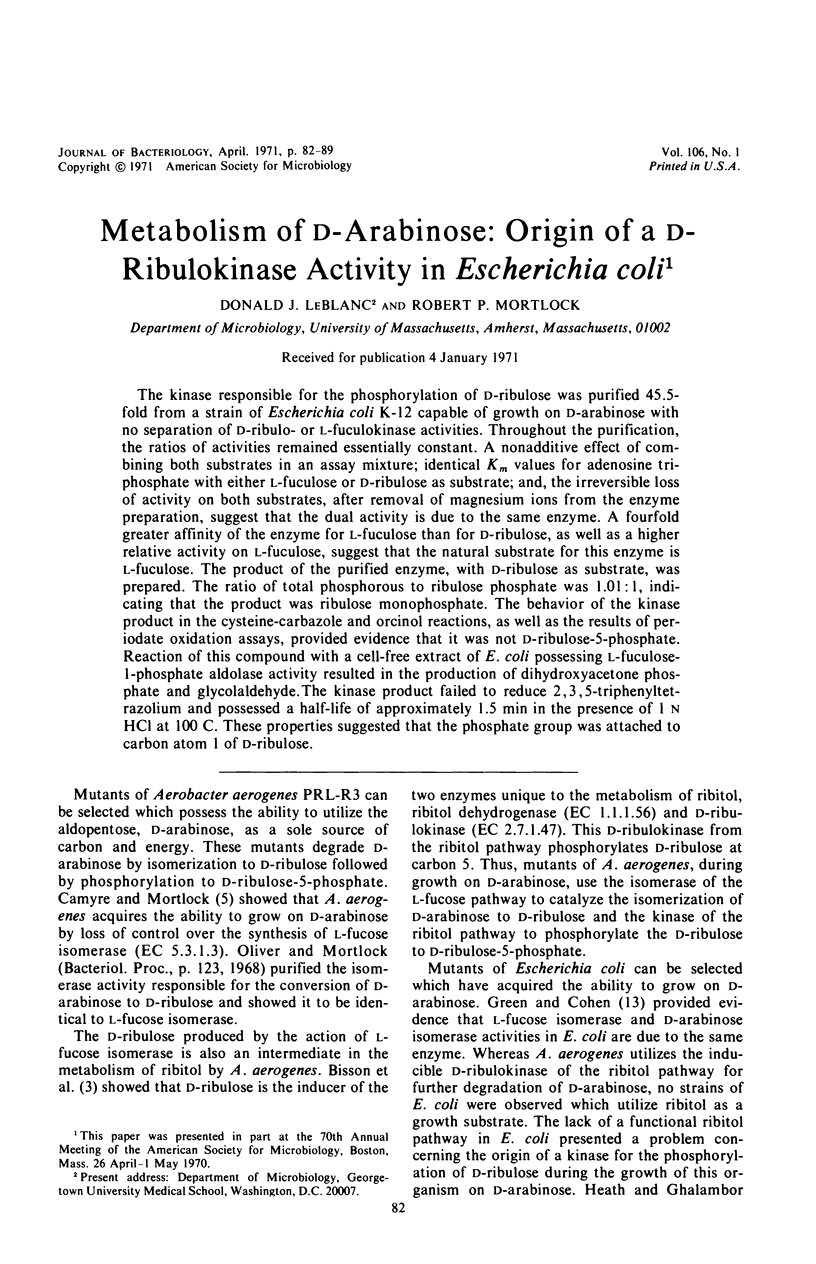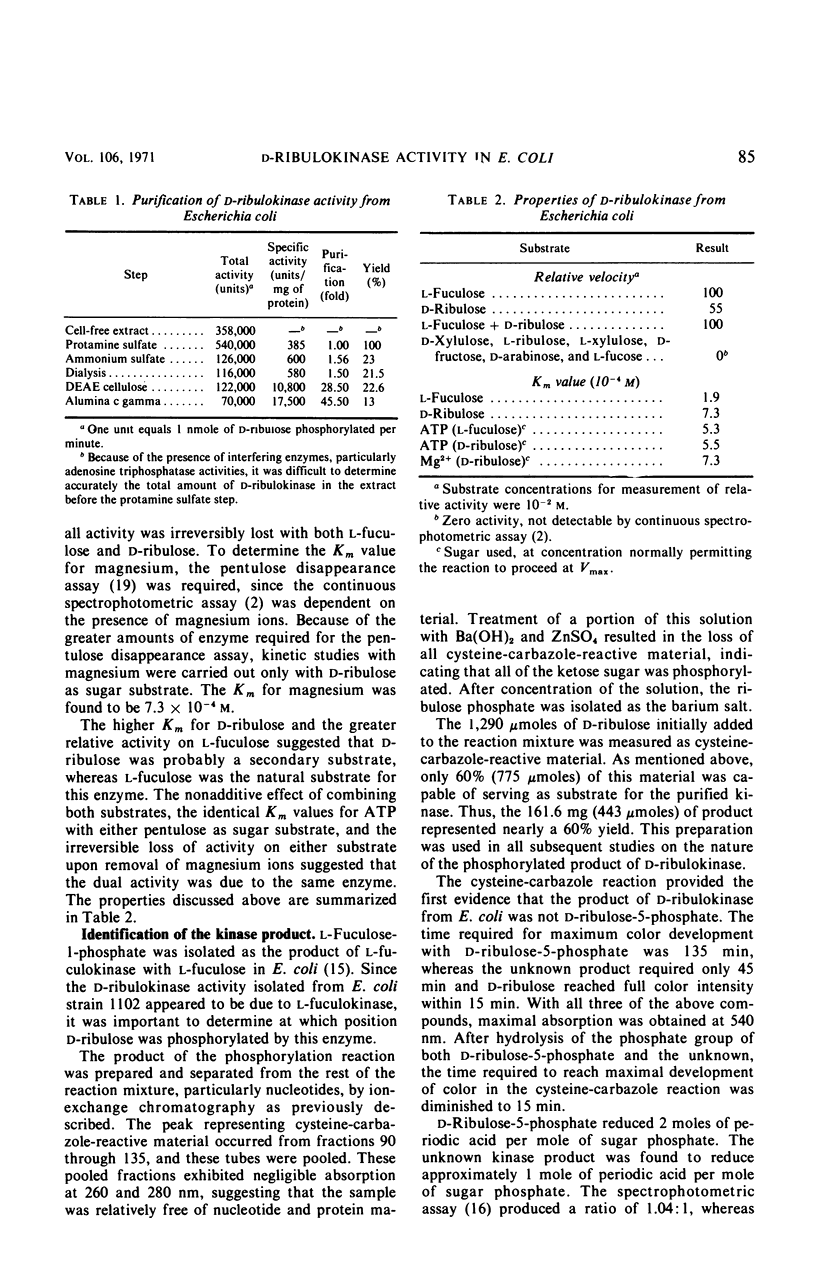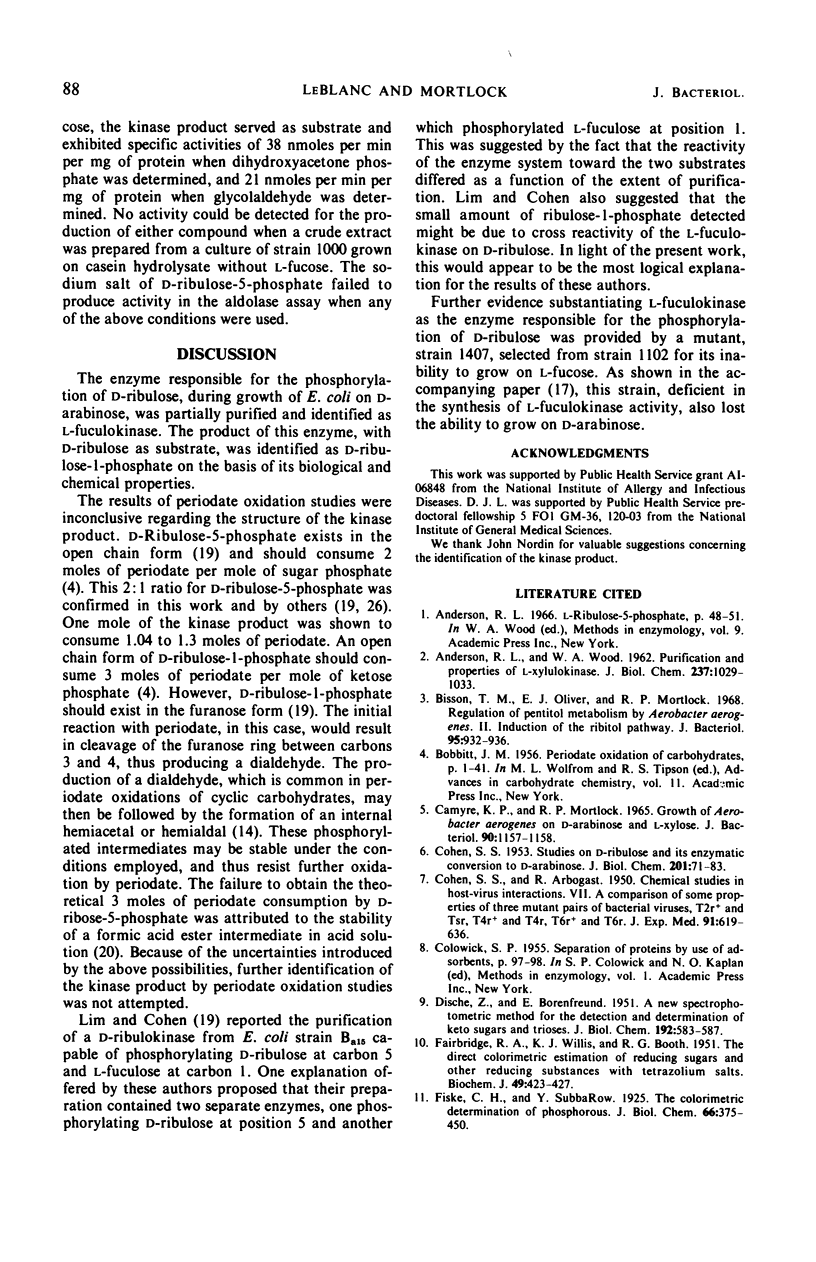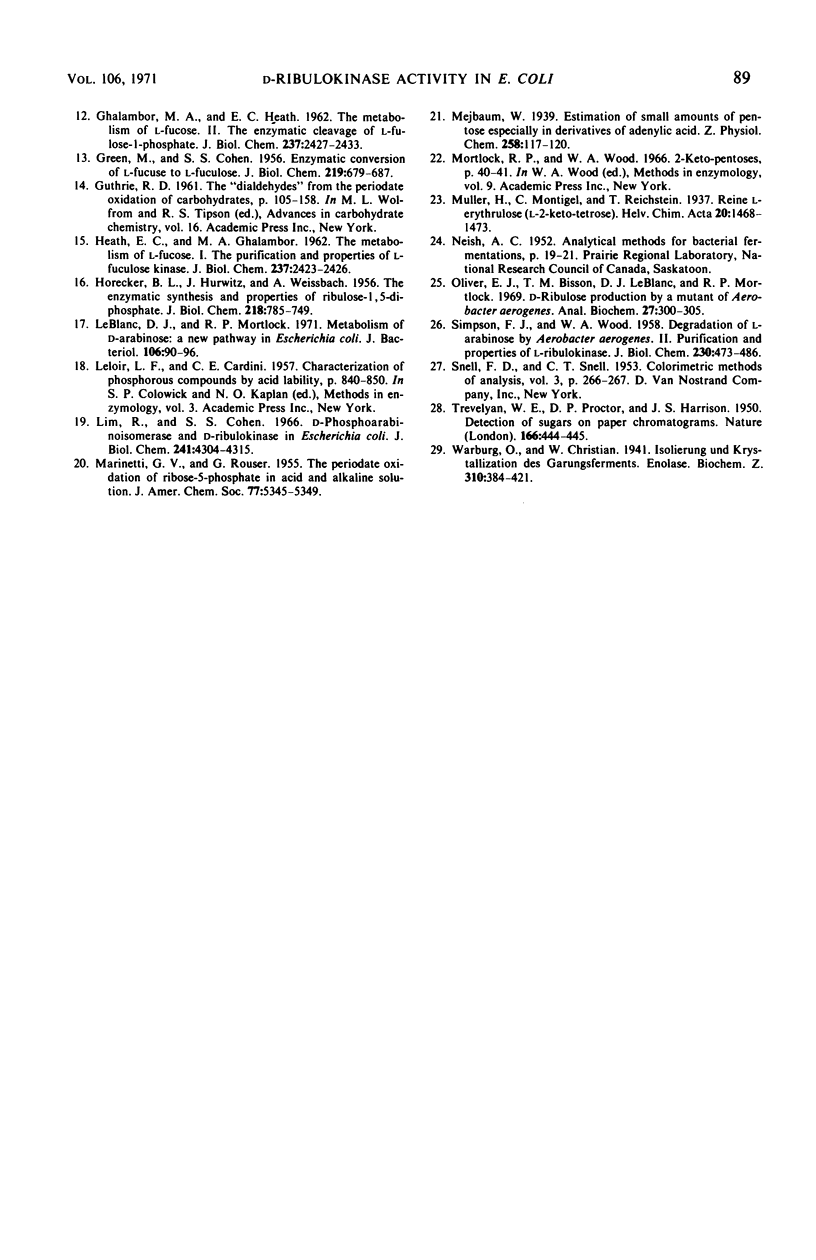Abstract
The kinase responsible for the phosphorylation of d-ribulose was purified 45.5-fold from a strain of Escherichia coli K-12 capable of growth on d-arabinose with no separation of d-ribulo- or l-fuculokinase activities. Throughout the purification, the ratios of activities remained essentially constant. A nonadditive effect of combining both substrates in an assay mixture; identical Km values for adenosine triphosphate with either l-fuculose or d-ribulose as substrate; and, the irreversible loss of activity on both substrates, after removal of magnesium ions from the enzyme preparation, suggest that the dual activity is due to the same enzyme. A fourfold greater affinity of the enzyme for l-fuculose than for d-ribulose, as well as a higher relative activity on l-fuculose, suggest that the natural substrate for this enzyme is l-fuculose. The product of the purified enzyme, with d-ribulose as substrate, was prepared. The ratio of total phosphorous to ribulose phosphate was 1.01:1, indicating that the product was ribulose monophosphate. The behavior of the kinase product in the cysteine-carbazole and orcinol reactions, as well as the results of periodate oxidation assays, provided evidence that it was not d-ribulose-5-phosphate. Reaction of this compound with a cell-free extract of E. coli possessing l-fuculose-l-phosphate aldolase activity resulted in the production of dihydroxyacetone phosphate and glycolaldehyde. The kinase product failed to reduce 2,3,5-triphenyltetrazolium and possessed a half-life of approximately 1.5 min in the presence of 1 n HCl at 100 C. These properties suggested that the phosphate group was attached to carbon atom 1 of d-ribulose.
Full text
PDF







Selected References
These references are in PubMed. This may not be the complete list of references from this article.
- ANDERSON R. L., WOOD W. A. Purification and properties of L-xylulokinase. J Biol Chem. 1962 Apr;237:1029–1033. [PubMed] [Google Scholar]
- BOBBITT J. M. Periodate oxidation of carbohydrates. Adv Carbohydr Chem. 1956;48(11):1–41. doi: 10.1016/s0096-5332(08)60115-0. [DOI] [PubMed] [Google Scholar]
- Bisson T. M., Oliver E. J., Mortlock R. P. Regulation of pentitol metabolism by aerobacter aerogenes. II. Induction of the ribitol pathway. J Bacteriol. 1968 Mar;95(3):932–936. doi: 10.1128/jb.95.3.932-936.1968. [DOI] [PMC free article] [PubMed] [Google Scholar]
- COHEN S. S., ARBOGAST R. Chemical studies in host-virus interactions; a comparison of some properties of three mutant pairs of bacterial viruses, T2r and T2r, T4r and T4r, T6r and T6r. J Exp Med. 1950 Jun 1;91(6):619–636. doi: 10.1084/jem.91.6.619. [DOI] [PMC free article] [PubMed] [Google Scholar]
- COHEN S. Studies on D-ribulose and its enzymatic conversion to D-arabinose. J Biol Chem. 1953 Mar;201(1):71–84. [PubMed] [Google Scholar]
- Camyre K. P., Mortlock R. P. Growth of Aerobacter aerogenes on D-arabinose and L-xylose. J Bacteriol. 1965 Oct;90(4):1157–1158. doi: 10.1128/jb.90.4.1157-1158.1965. [DOI] [PMC free article] [PubMed] [Google Scholar]
- DISCHE Z., BORENFREUND E. A new spectrophotometric method for the detection and determination of keto sugars and trioses. J Biol Chem. 1951 Oct;192(2):583–587. [PubMed] [Google Scholar]
- FAIRBRIDGE R. A., WILLIS K. J., BOOTH R. G. The direct colorimetric estimation of reducing sugars and other reducing substances with tetrazolium salts. Biochem J. 1951 Sep;49(4):423–427. doi: 10.1042/bj0490423. [DOI] [PMC free article] [PubMed] [Google Scholar]
- GHALAMBOR M. A., HEATH E. C. The metabolism of L-fucose. II. The enzymatic cleavage of L-fuculose 1-phosphate. J Biol Chem. 1962 Aug;237:2427–2433. [PubMed] [Google Scholar]
- GUTHRIE R. D. The "dialdehydes" from the periodate oxidation of carbohydrates. Adv Carbohydr Chem. 1961;16:105–158. doi: 10.1016/s0096-5332(08)60261-1. [DOI] [PubMed] [Google Scholar]
- HEATH E. C., GHALAMBOR M. A. The metabolism of L-fucose. I. The purification and properties of L-fuculose kinase. J Biol Chem. 1962 Aug;237:2423–2426. [PubMed] [Google Scholar]
- HORECKER B. L., HURWITZ J., WEISSBACH A. The enzymatic synthesis and properties of ribulose 1,5-diphosphate. J Biol Chem. 1956 Feb;218(2):785–794. [PubMed] [Google Scholar]
- LeBlanc D. J., Mortlock R. P. Metabolism of D-arabinose: a new pathway in Escherichia coli. J Bacteriol. 1971 Apr;106(1):90–96. doi: 10.1128/jb.106.1.90-96.1971. [DOI] [PMC free article] [PubMed] [Google Scholar]
- Lim R., Cohen S. S. D-phosphoarabinoisomerase and D-ribulokinase in Escherichia coli. J Biol Chem. 1966 Oct 10;241(19):4304–4315. [PubMed] [Google Scholar]
- Oliver E. J., Bisson T. M., LeBlanc D. J., Mortlock R. P. D-Ribulose production by a mutant of Aerobacter aerogens. Anal Biochem. 1969 Feb;27(2):300–305. doi: 10.1016/0003-2697(69)90036-0. [DOI] [PubMed] [Google Scholar]
- SIMPSON F. J., WOOD W. A. Degradation of L-arabinose by Aerobacter aerogenes. II. Purification and properties of L-ribulokinase. J Biol Chem. 1958 Jan;230(1):473–486. [PubMed] [Google Scholar]
- TREVELYAN W. E., PROCTER D. P., HARRISON J. S. Detection of sugars on paper chromatograms. Nature. 1950 Sep 9;166(4219):444–445. doi: 10.1038/166444b0. [DOI] [PubMed] [Google Scholar]


